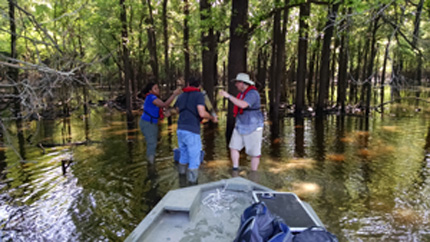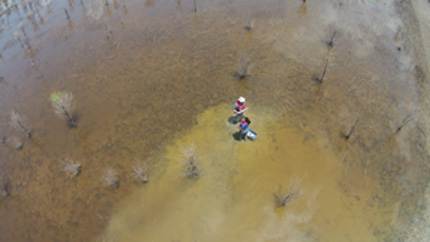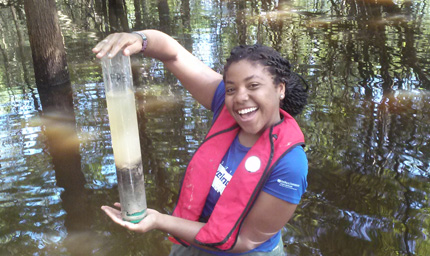5585 Guilford Road • Madison, WI 53711-5801 • 608-273-8080 • Fax 608-273-2021
www.agronomy.org
Twitter | Facebook
NEWS RELEASE
Contact: Hanna Jeske, Associate Director of Marketing and Brand Strategy, 608-268-3972, hjeske@sciencesocieties.org
Mighty river, mighty filter
Huckleberry Finn wouldn’t recognize today’s lower Mississippi River. Massive walls separate the river from low-lying lands along the bank, an area called the floodplain. Floodplains were once the spillover zone for the river. As people settled in floodplains, the land was converted into farms, homes, and businesses. Close to 1,700 miles of walls, or levees, keep the lower Mississippi River in check.
 “It’s less of a river and more of pipe now,” says John White, a coastal scientist at Louisiana State University (LSU).
“It’s less of a river and more of pipe now,” says John White, a coastal scientist at Louisiana State University (LSU).
Over the last century, the amount of chemical pollutants, in particular nitrogen fertilizer, in the river increased dramatically. When the river reaches the Gulf of Mexico, the pollutants create a low oxygen “dead zone” covering over 5,000 square miles. That’s partly because the Mississippi River is missing one of its main filters: the floodplain.
White and his colleagues at LSU research ways to remove pollutants from the river. One method is reconnecting the river to the floodplain. As rivers flow into floodplains they carry soils with them, creating a wetland. Wetlands trap chemical pollutants like nitrogen. The low oxygen and high organic matter in a wetland create a unique environment. As bacteria adapt to this environment, they convert fertilizer nitrogen into a benign nitrogen gas.
“There’s a whole subset of microorganisms that do this,” says White. “You just have to get the process going.”
 Reconnecting the river to the floodplain isn’t likely for most of the lower Mississippi valley, which runs from the Gulf of Mexico to northern Arkansas and Tennessee. However, a farm along one of the Mississippi’s tributaries recently became a floodplain on accident. The levee next to the farm broke in two places and flooded the area.
Reconnecting the river to the floodplain isn’t likely for most of the lower Mississippi valley, which runs from the Gulf of Mexico to northern Arkansas and Tennessee. However, a farm along one of the Mississippi’s tributaries recently became a floodplain on accident. The levee next to the farm broke in two places and flooded the area.
Fortunately, the U.S. Fish and Wildlife Service (USFW) had plans with the farm to break the levee and added another 4 breaks the following year to speed up the process. The USFW and The Nature Conservancy were already in the process of recreating a hardwood forest wetland on the farm. This type of ecosystem once covered most of the region, but only 20 percent remains.
It was a perfect opportunity for White and his graduate student, Nia Hurst, to study how the restored site compares to a natural floodplain. He and his team measured the levels of nitrogen removal from both the farm and a nearby forested wetland. The group also compared the soil properties of the two sites.
They discovered that the restored site removed almost as much nitrogen as the natural floodplain. The nitrogen removal rate was only 28% lower at the resotred site compared to the natural one.
 “The good news is that even though it hasn’t been restored for very long, the process of nitrogen removal has an almost immediate return,” says White.
“The good news is that even though it hasn’t been restored for very long, the process of nitrogen removal has an almost immediate return,” says White.
However, some of the other wetland soil characteristics hadn’t bounced back yet. Microbial properties that help wetlands filter pollutants, store carbon, or help plants grow weren’t nearly as healthy as the natural site. White says the area still has a long way to go before it’s fully restored.
“It’s going to take time to go back and we’re not sure if it will ever go back,” White comments, “But any project that we can do to take out that nitrogen helps the river and the coastal waters.”
White says there are only a few studies that show a restored ecosystem’s path towards recovery. This research traces the site’s baby steps toward becoming a wetland. It also proves that floodplains—natural or created— can significantly reduce the amount of nitrogen reaching the Gulf of Mexico.
Read more about the team’s research in Soil Science Society of America Journal. Field assistance was provided by The Nature Conservancy and assistantship funding was provided by the Louisiana Board of Regents for Hurst.
Soil Science Society of America Journal is the flagship journal of the SSSA. It publishes basic and applied soil research in soil chemistry, soil physics, soil pedology, and hydrology in agricultural, forest, wetlands, and urban settings. SSSAJ supports a comprehensive venue for interdisciplinary soil scientists, biogeochemists, and agronomists.